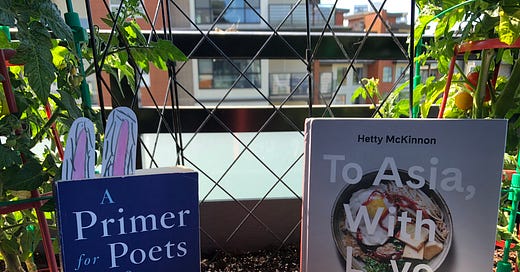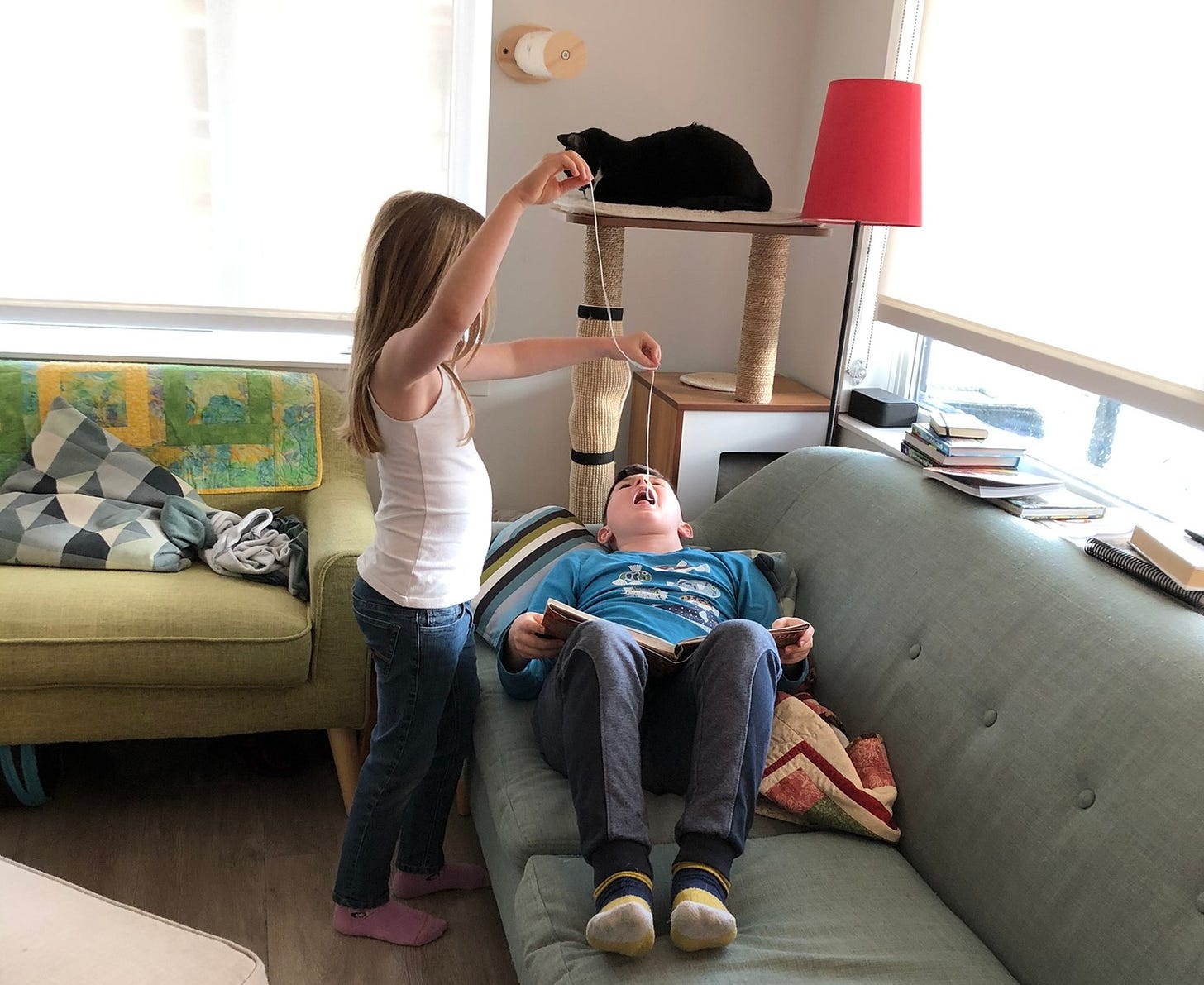Fried Shallots, Chaos Thresholds
A Cookbook and a Craft Book with Hetty Lui McKinnon and Gregory Orr
Hi Friends,
A while back when I was writing about Oliver Burkeman and distraction,1 I felt an impulse to add a caveat, to say, “This book has been out for a while / this might be old news / you’re probably aware / sorry to be late to the party.” But then I felt an answering surge of REFUSAL. What lurks behind this type of caveat?
An assumption that books get stale (sure, information can get stale, but that’s not the same thing), and
A sense that we could possibly read everything good right away (and if we don’t there’s something wrong with us or the thing wasn’t that good).
These are not actually things I believe. Sure, I know a buzz of coverage when a book is launching can help that book find readers, and sometimes I’m happy to be part of that. But I also believe books have long lives, and we discover them (or rediscover them) in moments when we need them (or are ready for them).
Over and over, I’ve mentioned a book that seems perfectly attuned to the interests of a friend or a student and found that they haven’t come across it yet. Joy of discovery! I’ve had this experience as a reader as well. I understand why people write about being ‘late to the party’ with a relatively new book, but the great thing about books is that we can get to them when we get to them! And no one could possibly get to all of the excellent books immediately!
A pleasure of writing a newsletter (rather than, say, pitching a column) is that I can write about whatever I want to (old books, popular books, small press books) without having to make a case for timeliness or importance.
So, welcome to a new series: A COOKBOOK AND A CRAFT BOOK in which I share notes on one cookbook and one craft book (which I understand broadly as anything that has helped me become a better writer or writing teacher). I’m writing about cookbooks alongside craft books because I love them both, but also because I believe creative process thrives on associative thinking.
A Cookbook and a Craft Book
I read a lot of cookbooks and a lot of craft books. In this series, I pick one book of recipes and one book on writing from my straining shelves and share notes on what I’ve learned from each.
Hetty McKinnon, To Asia with Love, Prestel Publishing, 2021
Gregory Orr, A Primer for Poets and Readers of Poetry, Norton, 2018
The Cookbook: To Asia with Love
When my friend Bridget came to Vancouver as book-historian-in-residence at UBC’s Green College, she was nervous to tell me she’d started eating vegan. Cooking omnivorously had been a pleasure we’d shared, and she didn’t want to seem difficult.
Fortunately, I had just checked Meera Sodha’s East and
’s To Asia with Love out of the library and could honestly reassure her that I was happy to explore vegan cooking together. Over the next few weeks, we cooked peppery bean sprouts with tofu, ginger-scallion miso-glazed eggplant, springtime rolls, mango pudding, and so many brothy noodle soups. When she went home to New York, I sent a copy of To Asia with Love to be waiting for her when she arrived. We’ve continued to text one another recipe suggestions and photos of our various attempts, now from Tenderheart too!Insights, enchantments, revelations of To Asia with Love:
Fried shallots. I already loved these. But this book had me making a big batch and adding them to everything.
Brothy coconut milk soups with rice noodles and heaps of greens. Easier than you might think.
White pepper. I got it for the salt and pepper eggplant, but I’ve been using it in soups too.
Temperature juxtaposition! Think warm rice, cold tofu, and then hot, flavourful, sticky-sauced Brussels sprouts. It’s great!
You might enjoy this book if:
You’ve been wanting to eat more vegetables.
You’d like to experiment with Asian flavors, but you’re not sure where to start.
You find it helpful when a cookbook offers substitution suggestions (ie. how to make a vegetarian recipe vegan, when you can switch to rice noodles to make a recipe gluten-free, what to use if you can’t find Japanese purple sweet potato].
You would like to watch someone feed someone else an extremely long noodle.2
You can follow along with
and her beautiful vegetable-forward recipes on Substack:Also, some of her New York Times Cooking recipes are on my repeat list, especially Sook Mei Faan (gingery creamed corn on cold silken tofu) and Snap Pea, Tofu, and Herb Salad with Spicy Peanut Sauce [these are gift links, so you should be able to view them without a subscription].
The Craft Book
When I first read Gregory Orr’s A Primer for Poets & Readers of Poetry, I was struck by how Orr articulated a bunch of things I’d sensed intuitively. Orr presents poetry as a constant negotiation between chaos (disorder, mystery, ecstasy) and pattern (which can happen through repetition and permutation of all kinds). He talks about the need to allow—even welcome—chaos (which might also be understood as uncertainty, mess, vulnerability) onto the page and the subsequent need to shape that material with the ordering powers of language and the imagination.
For Orr, powerful poems hover at a threshold where both pattern and chaos are tangible, where we can take pleasure in both satisfied expectations and the spark of surprise. He also points out that:
individual thresholds can vary from person to person and change over time, and
chaos might manifest as intense emotional material, or as language play that resists a clear single meaning, or in any other way a poem might challenge us.
A few underlined passages:
Lyric poetry is present in all times and places because it helps us live by expressing our experience and at the same time moving that experience a bit away from us—to the world of words, where it can be shaped or dramatized into meaning (16).
. . .think about opening yourself as one opens a door in the night: there is something alive out there, some entity or theme that wants to enter your room—the room of your mind, the room of the page. Don’t be afraid to put words down, no matter what they are—it’s essential to admit a few strange and unpredictable angels (47).
Insights, enchantments, revelations:
A clear and appealing way of thinking about poems in terms of Naming (image, specificity, concreteness), Singing (all kinds of sound work), Imagining (the work of metaphor and figurative language), and Saying (the language of declaration). I’ve used this framework in my Intro to Poetry lecture for 250 students, and it gives us a useful handle to discuss the wide range of work students are reading and making.
Ways of thinking about poetry that offer an alternative to the traditional-experimental binary (Like how sound can be both a force of order (through rhyme) and a force of chaos (through puns)!)
Poetry as most fundamentally a genre of pattern (and how pattern can happen in lots of different ways).
Fun nerdy stuff like vowel pitch!
[For your amusement, a little video I made for my students about vowel pitch and other fun nerdy sound stuff drawing on A Primer for Poets & Readers of Poetry.]
You might appreciate this book if:
You write or read poetry and you’d like to get a clearer sense of how poems make meaning or why certain poems affect you in certain ways.
You’re interested in poetry but wary of dry technical vocabulary (too much synecdoche and assonance in an English class?).
You teach poetry and you’re looking for language that gets at the heart of why humans need poetry and what reading and writing poems can offer us.
You can find these books (and all other books I’ve written about for Ok, But How?) in my Bookshop Collection.
Yours,
Bronwen
PS: When you heart a post, I see your name and know that the writing has reached you (and maybe connected with you) and send you a warm wish. Thanks for these!
I’m now slowly reading his Meditations for Mortals with my friend
, sending each other little response notes via text on each section as we go.Results not guaranteed.










What a wonderful connection to share with your friend. So happy you’re enjoying To Asia, with Love and the other recipes too. Keep cooking and sharing. Thank you for your kind words
I’ve been wanting to write about the Primer as it relates to comics making. This is extra inspiration. And the cookbook too! 🙏